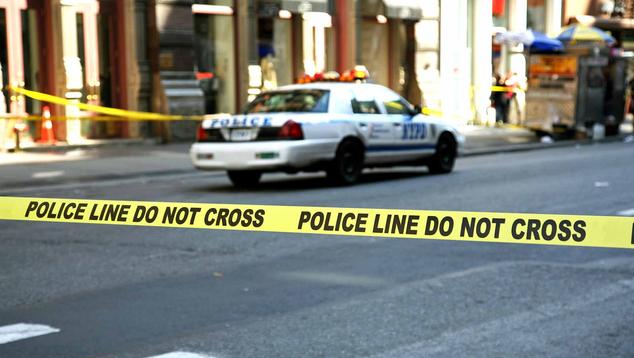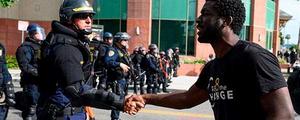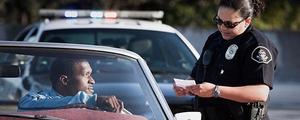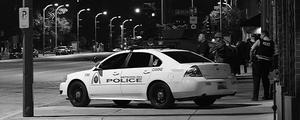Story Highlights
- 78% of Americans say there is more crime in the U.S.
- Increase in perceptions of more U.S. crime largely driven by Republicans
- Meanwhile, Americans less likely to perceive more crime in local area
WASHINGTON, D.C. -- Americans are more likely to perceive crime in the U.S. as having increased over the prior year (78%) than they have been at any point since 1993. Meanwhile, they are less likely to perceive more crime in their local area (38%) than at any point in Gallup's trend since 2004.
The gap between Americans' perceptions of more crime in their local area versus nationally is 40 percentage points -- the highest Gallup has recorded in three decades of tracking both trends.
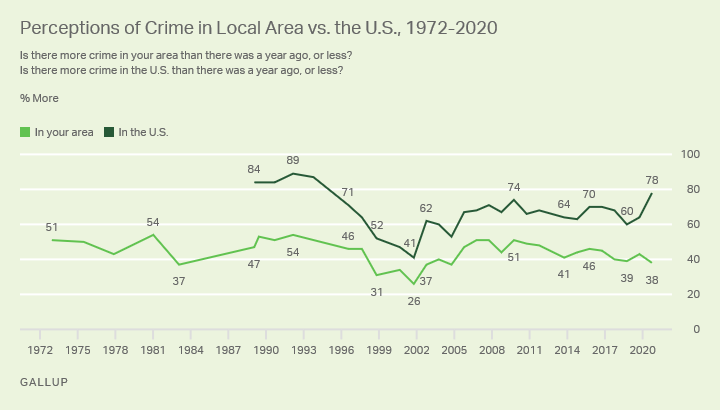
Line graph. Americans' perceptions there is more crime in the local areas and in the U.S. in general. 38% of Americans say there is more crime in their local areas, while 78% say there is more crim in the U.S. more generally.
The percentage saying there is more crime in the U.S. than there was a year ago is up 14 points from last year's 64%, marking a year-over-year increase not found in Gallup's trend on this measure since 2005.
Americans' perceptions of increased crime in their local area is down slightly from the previous year. This measure has been on a general decline over the past decade. As in recent years, Americans are about as likely to say there is more crime in their area than there was a year ago (38%) as they are to say there is less crime (39%) -- though historically, Americans have been more likely to say crime has increased in their area than to say it's decreased.
These data are from Gallup's annual Crime poll, conducted Sept. 30-Oct. 15, 2020.
Gallup has consistently found that perceptions of increased national crime have outpaced perceptions of increased local crime -- and that perceptions of national crime are not in tune with actual U.S. Bureau of Justice Statistics figures.
But the latest figures come toward the end of an unusual year. The coronavirus pandemic has kept many Americans in their homes more than normal since March, perhaps reducing traffic and outsiders in their neighborhoods.
Meanwhile, racial justice protests this summer -- many of which were peaceful and others that devolved into violence, looting and arson -- may have created an impression of increased crime in the U.S. as a whole.
Perceptions of the Seriousness of Crime Problem Stable
Though Americans perceive greater levels of national crime, they do not see the crime problem as being any more serious than they have in the recent past. Fifty-one percent say that the issue of crime in the U.S. is "extremely" or "very" serious -- consistent with the 48% and 52% recorded in 2018 and 2019, respectively. The 10% saying that local crime is extremely or very serious is also within the range of those same years.
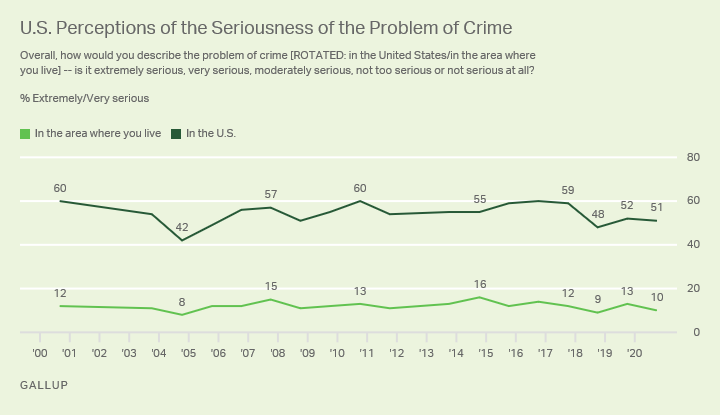
Line graph. Americans' perceptions of the seriousness of crime in their local areas and in the U.S. generally. 51% of Americans say crime is an extremely or very serious problem in their local areas, while 18% say the same of the U.S. more generally.
Increase in Perceptions of National Crime Largely Driven by Republicans
In most years, Gallup has found that those who identify with the party opposite the one occupying the White House are more likely than those identifying with the president's party to say crime in the U.S. has increased.
However, the latest figures offer an exception. Since last year, there has been a sharp increase among Republicans and Republican-identifying independents saying there is more crime in the U.S. than there was the previous year. The latest 83% among this group is up 24 points from last year and nears the previous high of 86%, measured in 2016.
Democrats and Democratic-leaning independents' opinions are similar to last year, although the 73% who say crime in the nation has increased is slightly higher than in 2019. The latest figure does represent the highest for Democrats since 2007.
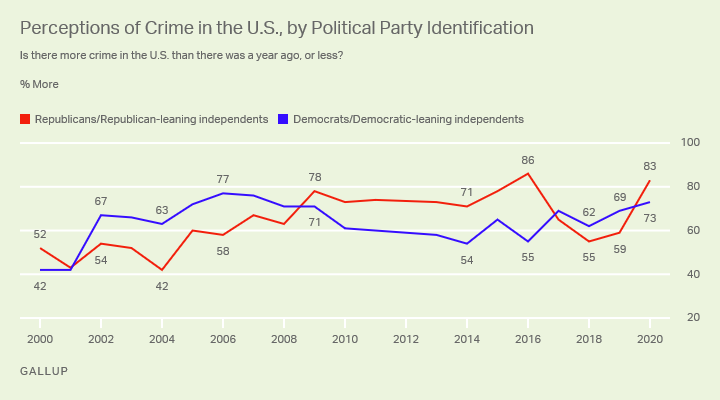
Line graph. Americans' perceptions there is more crime in the U.S. today than there was a year ago, by political party affiliations. 83% of Republicans and those that lean toward the GOP say there is more crime this year than last. 73% of Democrats and Democratic leaning independents say there is more crime in the U.S. than last.
There is little daylight between Republicans (38%) and Democrats (36%) in saying there is more crime in their local area. Both figures are down slightly from the prior year, consistent with the national average.
Three in 10 Feel Unsafe Walking Alone at Night in Local Area
This year's drop in Americans' perceived increase in local crime bears out in a separate measure asked on the latest survey. Since 1965, Gallup has asked, "Is there any area near where you live -- that is, within a mile -- where you would be afraid to walk alone at night?"
Currently, 29% of Americans say they would be afraid to walk within their local area alone at night. This is down from 37% a year ago and roughly matches the previous low of 30% recorded only twice in the last half-century, in 2017 and 2001 -- both years when reported household crime victimization was at its lowest.
This figure consistently ranged between 40% and 48% from 1972 to 1993. The overall decline in the trend since the early 1990s is consistent with the corresponding decrease in reported household crime victimization.

Line graph. Americans' fear of walking alone at night, within a mile of home. 29% of Americans now say they are afraid of doing so, down from 37% last year.
Bottom Line
In most recent years, Americans' persistent belief that crime worsened in the past year has been out of sync with federal crime statistics showing that crime rates have fallen. The asymmetry was less pronounced in 2000 and 2001, when Americans started reflecting more optimism after record declines in national crime rates made headlines those years.
The dynamics of 2020, however, may have eased Americans' concerns about local crime while putting a spotlight on violence nationally.
Much of this is politically driven. The mostly peaceful racial justice protests that occurred after the death of George Floyd at the hands of Minneapolis police were accompanied by extreme looting, arson and other violence erupting in some locations. Throughout the year, Democratic leaders and media have focused on the former while President Donald Trump, other Republicans and Republican media have highlighted the latter.
Official crime figures for 2020 released next year will give a fuller picture of the larger extent of both national and local crime. But for the time being, Americans perceive that crime has risen nationally -- even as they are less likely to report having been a victim of crime, more likely to think crime in their own area is down and more likely to say they're not afraid to walk alone at night where they live.
View complete question responses and trends (PDF download).
Learn more about how the Gallup Poll Social Series works.
